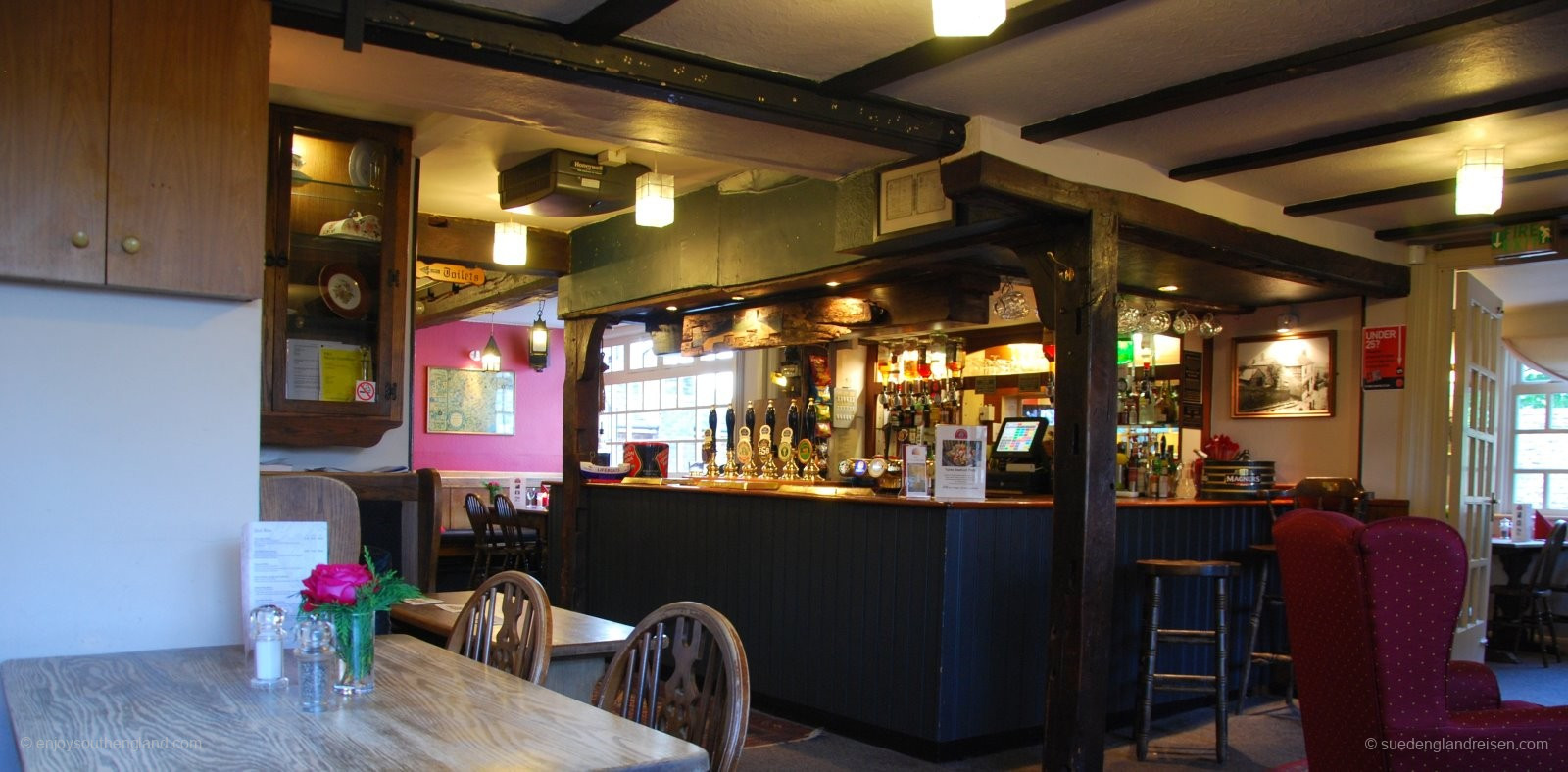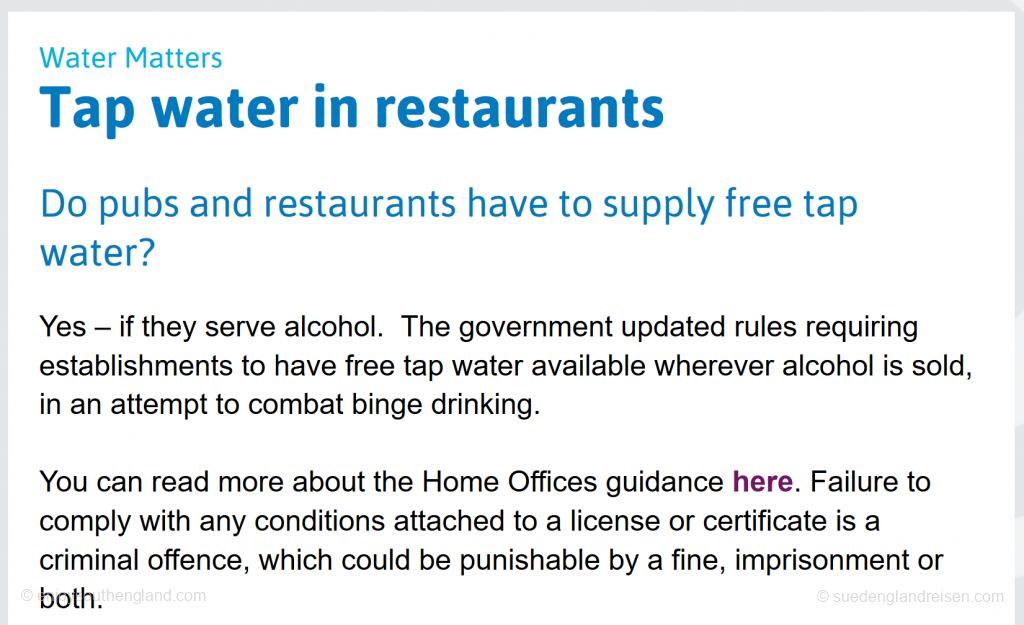
The bar in a typical English pub
As cosy and inviting as English pubs are, it’s easy to do something wrong there. That is not a bad thing and you might not even notice it right away, because the proverbial restraint of the English will not even result in an eyebrow being raised. It’s more fun though when you get it right. Sometimes you experience the opposite, as happened to us on our very first visit to a pub in England in 2009: Completely naïve we walked into the “George & Dragon” at noon in Salisbury. We saw a great beer garden at the back and went straight there. Almost all the tables were free so we sat down at a table in the sun and thought nothing more about it. That was the mistake! After a while, the landlady came from the bar and told us in her “strict teacher” manner that we were in an English pub and that it was customary there to order first at the bar and then sit down. There would be no table service here. Do you know the feeling of wanting the earth to swallow you up? That’s what we had but only briefly, because then supplied with drinks and an excellent meal we enjoyed this highly recommended pub with a terrace overlooking the river Avon. To make sure that you get it right, here are a few tips for your next (or first) visit to the pub.
Finding the right pub:
- Just look for very inconspicuous pubs – they are usually very nice. The nicest restaurants are not on the main street, so just follow the signs and enjoy what you find! The pubs are very proud of their “welcoming” atmosphere – everyone is welcome, they are “public houses”, simply “pubs”.
- Free houses are free because they don’t belong to a brewery! Therefore, they decide for themselves which types of beer are offered from which breweries. Otherwise, only the beers of the respective owner are usually on offer.
- Be careful if there is an advert outside for TV events such as football or pay TV (e.g., “Sky”) If this is the case, the television will be on and a conversation will be rather difficult, especially in the evening. If this is not advertised, there’s a great chance that there are no TV sets in the pub! This is because good British pubs, despite the British passion for television, do without this constant broadcasting and clearly rely on personal conversation (quite different from many Irish pubs and their replicas on the continent.)
- In most pubs there is also something to eat – but there are vast differences! In many (usually basic) pubs there is “pub grub”, This is simple food such as burgers etc. which tend to have more calories and are intended to encourage more drinking. In the “Gastro Pubs” (please ask exactly for these!) there are often really upmarket and sophisticated dishes, which are quite fun.
It is not very common for menus to be displayed. You can find this in cities in the tourist areas, but in the countryside, you usually have no idea what is on the menu before entering the pub. Therefore, it is worth searching the pub website on the internet (simply enter the place and pub name as search terms) in order to look at the menu which is usually displayed there. Beware: it is often only a sample menu from last season – so please do not expect that all the mentioned dishes are available. However, this is not decisive at all. Just by looking at the description of the dishes you can see whether they are rather simple or exciting and lovingly created. - The best method is always to ask for any recommendations at the property where you are staying. The hosts are usually extremely keen to recommend the right pub, especially in the privately run B&Bs. We have rarely been disappointed. It is also common to find a list of pubs and restaurants in the room (usually in the folder with information for the region.) Here again a menu search on the internet can be helpful as the vast majority of accommodation (including B&Bs) offer free Wi-Fi (usually called “free Wi-Fi”) – this is no problem. By the way, the hosts are happy to reserve a table for you at the desired time. They are very willing to help in any way they can. You almost always feel like you are in a carefree world.
- On Sundays, many restaurants are often closed. It’s better to enquire in advance. Please don’t be surprised that there is often only a very limited selection of dishes. At lunchtime, the “Sunday Roast” is almost always offered exclusively. You can usually choose between lamb, beef, pork and chicken. The whole thing comes to the table with gravy, vegetables and a potato side dish. Extensive and usually good value!
Entering the pub:
- The path always leads you first to the bar, the linchpin of the house.
- In “normal” pubs, both drinks and food are generally ordered at the bar and paid for in cash. Usually you are given an object (e.g., a painted cooking spoon with a number on or something similar), so that the waiter knows who ordered what. Just put it on the table and look forward to the food!
- In restaurants and “gastro-pubs” you usually get assigned a table (please don’t just sit down anywhere!) and the waiter takes the order at the table. If you want to pay, sometimes the waiter takes the money and sometimes you have to pay at the bar. Just wait and see what is custom of the house.
- When you come into the pub, you can see if there is a separate dining room. If so (especially if all the tables are set out), this is a clear sign of service. It doesn’t always say whether there are drinks at the table so go to the bar first and order your favourite drink there. When you get your drink, you can ask how to order the food. Either you are referred directly to a waiter (take your drink with you, then pay later!) or the menu is given to you and you can choose where to sit. If one of the waiters is there, you can also order from them. If you only get the menu, you look for a seat, choose the food and order and pay for it at the bar. You usually get the aforementioned painted cooking spoon or similar, which you place on your table so that the food carriers that bring the food out of the kitchen will find you. There is no more service, but you can sit for hours undisturbed.
- When you arrive at a pub and all the tables are occupied, don’t be afraid to ask politely whether you are allowed to sit down. The people already sat at the table are usually extremely pleased about this and immediately start up a conversation. This is almost the best way to get in touch with the locals!
Order drinks:
- It is usual to order alcoholic drinks in the pub and this is normally beer and cider (a type of alcoholic apple juice, usually carbonated). Of course, there is also wine and soft drinks. Beer and cider are usually served in two sizes: “pint” or “half pint”. If you don’t say anything, the landlord (bartender) serves you a pint. By the way a pint is 0.568 litres and half a pint is 0.284 litres.
- Beer: England has a huge number of local and smallest breweries. The range of beer on offer is therefore varied. It is customary to order a “draught beer”, i.e., a freshly tapped beer not from a bottle (except for pubs that specialize in special craft beers, but you can see that). A distinction is made between the carbonated beers (very similar to or even imported from continental beers, usually “Lagers” of large international breweries such as Heineken, Stella Artois, etc.) and the classic English “ales“. The latter are very low in carbon dioxide and are tapped into a glass with muscle power at beer cellar temperature. English pubs are very proud of their “Real Ales”, i.e., particularly craft and sophisticatedly brewed beers, mostly made from locally grown raw materials. The “draught” beers (and ciders) are advertised at the large taps with artistically designed signs. Therefore, it is best to look at all the signs first and only then order the right one.
- Cider: A drink that has become very popular in recent years is cider – a mixture of fermented apple juice and non-alcoholic apple juice, mostly carbonated. Only the ciders referred to as “vintage” are non-carbonated. Cider is available from “dry” to “medium” to “sweet” and everyone has a really different taste. There’s no getting around it and you can gradually test each one. Some pubs have “cider festivals”, where more than 20 varieties are served.
- If you don’t know any of the beers or ciders on offer, just chat with the “Landlord” (barkeeper) to find out your personal favourite. You can almost always get a sample to taste and find the right one, from which you should order a “pint”, i.e., about 0.568 litres (the large glass). Otherwise just take “half a pint” (just under 0.3 litres) and try it out! You’ll be surprised at what exciting things there are on offer.
- Wine: If you prefer a glass of wine, you will actually get your money’s worth everywhere. The selection is usually large and ranges from wines from France to Spain to the “New World” (especially Australia, but also Africa and California as well as Chile). Even though more and more (and sometimes surprisingly good!) wine is produced in England, it is practically non-existent in gastronomy. It’s a pity, but all the more worthwhile to visit a winery in the south of England.
Wine drinkers usually have the choice of different glass sizes: Small: 1/8 = 0.125 litres medium = 0.175 litres Standard / Large: 1/4 = 0.25 litres. Be careful: The selection of wines is often large, but not those which are served by the glass! The prices for a glass of wine are quite high but for the whole bottle, on the other hand, they are comparatively moderate. Thus, for two wine drinkers at the table, it is worthwhile to buy wine by the bottle rather than by the glass. - Alcohol-free drinks: Of course there are also a lot of soft drinks in the pub. We also know a “Ginger Ale” or “Tonic Water” and also a “Coke” or “Sprite” / “7Up”. Also popular is “Sparkling Elderflower”, i.e. a carbonated elderflower drink (e.g. from “bottle green“).
Usually the soft drinks are lined up on a shelf on the wall behind the counter and you can choose what you want. Otherwise: Just ask the landlord (host)! Good quality tap water is available everywhere. There is also a great law which states that every restaurant that offers alcohol must also give out tap water free of charge!
Choose the food:
- We have written an own travel tip with many examples of English food itself and its now outstanding quality.
- The food almost always comes with a salad or vegetables – even if it is not included! In particular the vegetable side dishes are usually large portions of low-salt and bite-proof steamed seasonal varieties.
- At least one vegetarian and often another vegan dish on the menu are standard.
- There is almost always there is at least one Asian/Indian dish as well as a pasta dish on the menu. Delicious, but please don’t expect an Italian “Al-Dente”!
- Many pubs are very proud that their food is made of local ingredients and are organic.
- The salads are sometimes without dressing but don’t be surprised. Just ask nicely for some dressing and they will be happy to bring it to you.
- • Meal hours are noon 12-14 (sometimes 11:30 – 14:30) and in the evening 18 – 21 (sometimes 17:30 – 21:30). Outside these times, it is almost impossible to get something edible except in the larger cities. In the afternoon there are also Tea Rooms, which have excellent sandwiches! However, the cafés at tourist attractions (e.g., gardens, houses, etc.) are open most of the day and you often get into them without paying an admission charge! In the evening there is often only a takeaway or a supermarket or one of the rather rare petrol stations open until 10pm.
How to pay:
- Payment is usually made directly at the bar. There is an unwritten law that you don’t touch the glass on the bar until you’ve paid!
- Almost anywhere you can be paid by card. Payment by credit card is common, which is also accepted without trial for small amounts.
- Tips are accepted, but is rather unusual – especially in pubs at the bar. The bill is always to be paid pence-precisely – almost always on the counter there is a plate or a glass for the “tip”. Just put in 50 pence or a pound, depending on how you feel. A “tip” for the waiter, on the other hand, is very common. As a rough estimate you can give 10%, but that is not fixed. Less than this will never lead to a protest by the waiter – we are not in the USA after all! Beware: In some tourist restaurants, the tip is already added to the bill as a “service charge.” There is no need to give a tip twice.
Closing time
- The legal curfew has officially been abolished and pubs now decide for themselves how long they want to keep open. However, the self-defined opening hours are strictly adhered to and the call or bell for last orders can usually still be heard. Otherwise, the landlord comes round when there isn’t much going on and asks for last orders.
Smoking in the pub: Definitely not!
- England is very strict: smoking is generally banned in pubs! If you want to pursue your addiction, just grab a drink (in the evening maybe also a candle from the table!) and go out into the street. There is certainly a small table and two chairs outside so you can continue to have a friendly chat.
Finally: Go there yourself!
- Under “PUBs” we mention a few nice pubs from our travels. The best method is still easy. Just go in and try it for yourself! :-)





